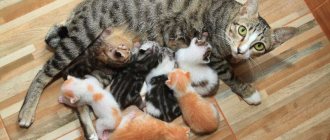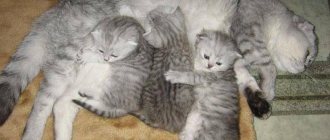12462Administration
6
It is very important for the owner to notice the signs of childbirth in a timely manner for the owner, because this is what makes it possible to accurately determine the duration of the birth process and, if necessary, provide assistance to the pet. If you miss the start of lambing, it may be difficult to determine whether intervention is necessary. If the animal’s condition is good and the process is going correctly, then intervention is not required. When the birth of kittens is delayed, a veterinarian is necessary. After examining the four-legged woman in labor, he will determine the need for one or another assistance.
Complications during childbirth are more often observed in purebred animals and too young females, whose body has not yet fully formed. Outdoor cats, which have the opportunity to constantly be in the fresh air and spend time actively, rarely encounter problems during pregnancy and lambing due to the fact that their bodies are strong and well-trained. He can easily bear the load and easily prepares himself for the birth of kittens without any intervention. However, signs of impending birth in a cat that lives at home should alert their owners. If there is a week left before the birth of the offspring, a female who gives birth not for the first time may have completely absent signs.
© shutterstock
Cat before birth
So, as we have already said, the first signs of impending birth are observed 7-10 days in advance.
From this period, the owner should pay special attention to his cat. If she goes for a walk outside the house, take her from the street and try not to leave her alone for a long time
You can tell that a cat is ready to give birth by the following signs:
- often lie down in a prepared box on your back;
- in the stomach you can visually notice the active movement of kittens;
- the cat begins to actively wash itself, lick the genitals, even to the point of licking off all the fur under the tail;
- a day before giving birth, she is constantly in the birth box, from where she comes out to drink water or milk;
- does not eat anything on the last day before giving birth;
- The animal's genitals become noticeably swollen, and redness of the nipples and skin under the tail is also observed.
Have you noticed these signs in your cat? Then you no longer have to wonder how long it will take for her to give birth. Here everything is already extremely clear - childbirth can take place at any minute within the next 24 hours! Be prepared for this process and purchase everything you need in advance in case complications arise during labor.
How can you tell if your cat has started giving birth? Before giving birth, a mucus plug comes out of the cat’s genitals, then the birth process begins, during which the cat can meow loudly and pitifully. At this moment, the owner should be nearby and calm his pet with gentle stroking and kind words of support.
To make it easier for you to navigate this difficult matter, consult in advance with a veterinarian who will answer all your questions in detail. Childbirth can happen differently for each animal.
For example, ordinary cats that do not have pedigree roots often give birth on their own. The owner may not even notice this process and see already born kittens affectionately eating their mother's milk.
It is impossible to predict how the birth will go. This depends on the individuality of the animal’s body and whether the cat has given birth before. Young individuals bearing offspring for the first time take longer than usual to give birth and often scream loudly. Due to lack of experience, such cats often try to run out of the box, which is not at all recommended.
It is also not advisable to allow rollovers and squats. In such positions, a cat can seriously harm her kittens. To eliminate such risks, the owner needs to control the birth process and prevent such positions of the animal’s body. It is better to carefully turn her on her side and gently stroke her stomach and back. This will calm the frightened mother cat a little.
Even an inexperienced owner will notice that the cat has begun to give birth. The first kitten will emerge from the genitals of the expectant mother. At this moment, the woman in labor will strain and push very hard, thereby trying to quickly push the baby to the light.
The first kitten may be in the amniotic sac, which occurs if it does not burst during birth. The cat will be able to free the baby from the bubble by carefully gnawing the shell.
If this does not happen, take the initiative and free the newborn from the bladder using sterile scissors. When cutting the shell, be extremely careful and attentive so as not to harm the kitten.
How can you tell if your cat is no longer giving birth? The frequency of birth of each kitten is 15-40 minutes. This means that you won’t have to expect a quick birth. After the kitten is born, the placenta emerges from the genitals, which she must eat. This will allow the woman in labor to quickly realize motherhood and speed up the lactation process.
As a rule, the owner does not have to persuade the cat; it eats the placenta by force of natural instinct.
After the placenta is delivered, you can understand that she gave birth to all the kittens and has already finished giving birth. It is very good if the birth was successful for both the mother cat and her offspring. But sometimes complications occur, which we will now talk about!
First signs of labor
How a cat behaves before giving birth can be understood from its behavior. The very first signs are the removal of the animal’s plug. It is called a traffic jam in a figurative sense. It is a natural beige-pinkish lubricant that comes out of the genital opening. In this way, the body clears the path for the animal’s fetuses to exit.
The surest sign is that your water is breaking. Therefore, the animal must be in a place prepared for lambing so as not to stain the sterile areas of the apartments. To prevent the cat or litter from being in danger, the area designated for cat birth should be fenced off. For example, you can take a spacious box and put disposable sheets inside.
Newborn kittens
Labor can be considered to have begun when the genital opening opens and the kittens are gradually born. The last kittens (1-2) may be born slowly. That is, there is no need to rush if it seems that lambing is already over.
Can there be false births?
Can a cat have false contractions? Can and should be present for facilitated real childbirth. False contractions begin several hours before real labor. Contractions are spasms of the uterine walls that cause the kittens to turn over in preparation for lambing. This is an absolutely normal phenomenon that prepares not only the animal, but also the owner. After false contractions, it is necessary to monitor the cat’s behavior; you should not allow activity, although the animal is unlikely to get out of its bed.
Possible complications are milk fever or eclampsia. It may not occur during the first birth, but during the second and subsequent births it may appear. But if it happened the first time, then you should expect it to happen again next time. Does a cat always have false contractions? No, but in most cases they happen. The absence of false labor can aggravate the situation. During false contractions and real lambing, the owner can consult a veterinarian by telephone. And in order to relieve himself of the difficult responsibility of delivering a baby, he can give the animal to the clinic so that professionals can deliver the baby. False contractions last on average 1.5 hours, and real labor lasts up to 4-5 hours.
Harbingers of imminent birth
On the day the cat gives birth, you can observe signs of labor in the cat:
- No appetite. The cat is limited to water or milk, and prefers liquid dishes (broth, for example) from food. This is the very first sign that the body is preparing for lambing.
- The female spends all her time in the place she has chosen for childbirth. She doesn't go out for walks at all.
- The cat will constantly lick the genital opening, where birth will take place. They do this to remove the discharge so that there is no discharge during childbirth. The presence of discharge can cause infection.
- During sleep and rest, the kittens will constantly move in the stomach. Before giving birth, they take positions that are convenient for lambing. The larger the kittens and the more of them, the more pronounced the movements will be.
- The plug comes off. Cork is a thick pinkish mixture that is released literally an hour and a half before lambing.
- The nipples swell and colostrum is released. This can be checked by gently pressing on the nipple. It will come out with a white mixture.
- About 5 hours before the real birth, false contractions appear, the cat becomes hunched over, as if preparing a comfortable position before lambing. This is one way to understand contractions in a cat. False contractions are needed to prepare kittens for birth. At the same time, the uterus does not open, the cat behaves restlessly.
- The waters break about an hour before lambing; in primiparous cats, they may break with the birth of the first kitten.
False contractions
All of the above symptoms will help to accurately determine imminent labor. Childbirth must be monitored. It is better to prepare the place and sterile unnecessary rags in advance. For example, you can buy several disposable diapers at the pharmacy.
How is childbirth different for pets?
Childbirth in cats
Cats usually give birth faster than dogs.
The harbingers of labor take only a few hours for them; the birth itself and the intervals between babies pass faster. However, if there are complications or abnormal births, they are more likely to end in caesarean section in cats than in dogs.
An important point to know!
Remember that even normal childbirth is extremely stressful for the body. But it is your pet who is giving birth, not you, so you should not increase stress by infecting your pet with your nervousness. No matter how much what is happening scares you, control yourself, talk to the animal in a calm and confident voice, know that it is from you that it expects support. Prepare for childbirth in advance: read the literature, enlist the help of a doctor, find out the number of a 24-hour clinic to be fully prepared.
Do not panic! Animals sense your condition and may become frightened, which can lead to them hiding from you. Create the most calm and comfortable environment for the animal. You shouldn’t grab it and rush to the clinic to give birth if there is no reason for this. Traveling is an additional stress, which, especially in cats, can lead to the cessation of labor. If you are very worried and unsure of your abilities, it is better to invite a doctor to your home. You can call the clinic and get doctor's advice.
We will tell you how a normal, uncomplicated birth proceeds.
How do you know when an animal is due to give birth?
There are even special online calendars on the Internet that are very convenient. Enter the mating date and get the estimated due date. If you are not sure or do not know the exact date, you can do an ultrasound to determine the date. A good diagnostician uses ultrasound to determine the period with an accuracy of up to a week.
However, even the best doctor can make a mistake with the number of fetuses. The fact is that the uterus in animals is two-horned, shaped like the letter V, so during research you can easily make a mistake by counting the same fetus twice. The exact number of babies can only be determined by x-rays, but this method is not recommended for pregnant women. If the owner insists, then he takes the risks for the consequences.
Possible problems during childbirth
In medicine, difficult births are called pathological.
The first pathology is a violation of the position of kittens before birth. Presentation can provoke birth injuries and pathologies in the future. This is preceded by a lack of calcium, as the cause of asynchronous contractions of the uterine muscles.
This pathology can occur during contractions (first stage), then when the body begins to push out the fetus (second stage), and when the kitten emerges from the genital opening (third and final stage). The animal may hiss and scream loudly.
Note! In purebred cats (Bengal, Fold, British, Scottish, and so on), problems and pathologies are more common than in outbred cats. Therefore, veterinarians strongly recommend seeking regular diagnostics.
And during pregnancy, a specialist will tell you whether pathology should be expected and what kind. Obstetrics may be required.
The second pathology is more related to the cat itself. If the postpartum membranes do not come out during childbirth, they will cause apathy and a bad mood for the cat. The consequence of this will be refusal to care for children, bad mood, lack of appetite and brown discharge. True, for Thai and Sphynx cats, discharge and licking are not always a symptom, because the nature of the animal differs from simpler cats (British or Scottish, for example).
Obesity
These are just 2 of the most common pathologies; they can be caused by poor health, obesity, large fetuses and dozens of other reasons. As a rule, most pathologies can be detected by ultrasound.
Video
Postpartum problems
Childbirth is behind us, but the owner must remain vigilant - the cat may develop new problems. The table shows the most common ones and ways to solve them.
Problem What to do
The cat refuses to eat
Immediately after giving birth, the cat may not ask for food for up to 6 or more hours due to the afterbirth eaten. If you fast for more than a day, you can give her low-fat broth; it contains extractive substances that stimulate the digestive activity of enzymes and the functioning of the gastrointestinal tract. If you have an intestinal disorder (may occur due to a large amount of afterbirth eaten), you need to give the pussy sorbents. When the mother's condition stabilizes, she will have an appetite.
It is important that she drinks water while refusing food.
The animal does not visit the litter box
In the first four days after giving birth, the cat may not want to go to the toilet. This is a normal phenomenon associated with the formation of milk and the restoration of internal organs, which requires a lot of fluid.
There is a discharge mixed with blood
If the volume is small, the cat’s discharge within two days after birth is considered normal and goes away on its own
You need to sound the alarm if the discharge has a pronounced scarlet color, lasts more than two days, or intensifies. This may be a sign of internal uterine bleeding or the presence of serious tissue ruptures. The cat should be taken to a veterinarian immediately.
A woman in labor has no milk
There can be many reasons for this phenomenon - from the cat’s stressful state to internal endocrine disorders. It is important to provide the new mother with complete peace: care should not be excessive. There is no need to move the box with the family to a new place or pick up the kittens. It is necessary to ensure that they are not disturbed by other pets or children. If bowls of food and drink, as well as a tray, are located far from the place where the cat and kittens are located, the pet may worry about the cubs, leaving when necessary. In addition, for a cat to have a sufficient amount of milk, its diet must include dairy and fermented milk products and water.
All that's left is the belly
First of all, it is necessary to exclude the possibility of the presence of a kitten in the uterus, while a dead fetus poses a great danger. You can independently determine its presence by palpation, but it is better to go to the clinic and do an ultrasound. In the absence of a fetus, the cause of the abdomen may be intestinal disorders, helminths, or difficulty with defecation.
An empty bubble came out
The amniotic sac may rupture as the kitten passes through the birth canal, or the cub may be born in it. In some cases, the membranes are expelled before the kitten is born. You can't let the cat tear it apart before the baby arrives. An emerging bladder without a fetus after delivery is not considered a pathology and does not pose a danger to the animal - it is a physiological feature.
Signs of eclampsia appeared
Eclampsia is a phenomenon based on calcium deficiency in the cat’s body. Symptoms: increased salivation, poor coordination of movements, anxiety, increased body temperature, convulsive muscle contractions. This condition leads to the death of the animal, so at the slightest sign you need to urgently take the cat to the clinic. A preventive measure is to take calcium-containing products during the period of gestation and feeding of kittens.
Prevention of a short umbilical cord
Since there is currently no effective treatment for this pathology, doctors recommend reducing the risk of its development even when planning pregnancy. If a woman cannot do anything about the hereditary physiological characteristics of her own body, then she is quite capable of the following actions:
- Avoid smoking, drinking alcohol and narcotic substances, which can cause disruption of the development of the placental apparatus;
- Prevent fetal hyperactivity by reducing the consumption of stimulating foods such as coffee, cocoa, chocolate, etc.;
- Be in the fresh air more often in order to maximally saturate your own blood with fresh oxygen, which will at least partially compensate for possible fetal hypoxia;
- Do not come into contact with toxic chemicals (varnishes, paints, industrial gases, etc.) during the period of preparation for pregnancy and gestation;
- Eliminate or minimize stressful situations - for example, changing jobs, leaving a dangerous urban area for a while, etc.;
- Make your diet more varied, rich in vitamins and other beneficial substances - especially iron and magnesium compounds, which will improve blood oxygen saturation;
- Avoid heavy physical activity and injuries, as they can lead to hyperdynamia of the fetus and the umbilical cord entwining around it.
Regularly scheduled medical examinations during pregnancy allow early diagnosis of possible pathology. If the expectant mother has relatives who were born with a short umbilical cord, or she herself had this anomaly, it is recommended to undergo examination by a geneticist.
If you suspect a short umbilical cord in the fetus, it is important to seek quality medical care. It can only be provided in licensed clinics staffed by qualified doctors. Also, the mother herself is required to completely trust the attending doctor and carefully follow his recommendations. You should not be afraid of such radical steps as a caesarean section - this is a long-established and simple operation that significantly reduces the likelihood of complications.
How does the feline birth process work?
Cats bear offspring for about 64 days, in rare cases - up to 70 days. On average, there are 3-5 kittens in a litter, but cases of the birth of eight cat cubs have been recorded. The duration of labor is influenced by several factors: age, number of fetuses, number of previous lambings, breed, diet during pregnancy. On average, the process of childbirth in cats takes from several hours to a day and a half, and includes periods of contractions, pushing and expulsion of the fetus.
The cat's first contractions may be invisible to others because they are still weak. At this time, your pet can be busy arranging the nest. As the contractions intensify, the cat may moan, meow, and its body periodically tenses in efforts. Then the cervix opens, the mucous birth plug emerges through the birth canal, followed by the first kitten.
Kittens are born “in order”, usually with a break of half an hour to 12 hours. Their birth may alternate with the expulsion of the placenta, which the cat sometimes eats. Kittens are born in the embryonic membrane (amniotic sac), the cat chews it, licks the cub, then bites the umbilical cord. The mother can begin feeding already born kittens in between contractions.
If your pet ignores the newborn kitten, the owner present at the birth will have to open the amniotic sac himself, carefully wipe the kitten and place it next to the mother. During the birthing process, your cat may need several hours of rest.
It is difficult for an inexperienced cat owner to understand whether all the kittens have already come out, or whether this is a break in childbirth. Even an ultrasound scan performed during pregnancy does not always reliably determine the exact number of fetuses. You can focus on the signs of the end of the birth process
During the birthing process, your cat may need several hours of rest. It is difficult for an inexperienced cat owner to understand whether all the kittens have already come out, or whether this is a break in childbirth. Even an ultrasound scan performed during pregnancy does not always reliably determine the exact number of fetuses. You can focus on the signs of the end of the birth process.
Birth of the fetus
As soon as the kitten comes out, it is covered in a shell. The mother must carefully tear it apart and bite off the umbilical cord. The cat begins to intensively lick the baby, which helps clear his respiratory tract of mucus. The kitten should squeak - this is a sign that it is breathing. After or along with the kitten, the placenta comes out, which the mother can eat. If the offspring is large, you should not let her eat more than 3 afterbirths.
You need to make sure that all traces come out. Their number should correspond to the number of fruits. The placenta remaining inside can cause serious inflammatory diseases.
In the intervals between births, it is necessary to ensure that the mother does not lie on the newborn kitten. Due to the pain and discomfort, she may not notice it and accidentally press it down.
When all the babies are born, it is necessary to organize complete peace for the family. The mother will lick and feed her babies, so there is no need to disturb them too much. If a cat has eaten the afterbirth, she may not eat for several hours after giving birth. It is necessary to leave her something to drink and place a toilet nearby so that she does not go far from the offspring.
Normal pregnancy process, stages and timing
In a healthy animal, the process of pregnancy and childbirth occurs without the need for intervention or assistance. In purebred, small, problem cats, childbirth may occur with complications. In more developed countries, there is a special profession - zooobstetrician, a specialist responsible for the favorable course of childbirth, preserving the life and health of the mother and offspring. In “our realities,” all responsibility falls on the shoulders of the owners and general veterinarians.
On average, a normal cat pregnancy lasts 60–65 days, but the period can vary by 7–10 days depending on the breed and body composition of the expectant mother. Conventionally, pregnancy is divided into 3 stages:
- Mating – 3 weeks: after mating, the cat experiences swelling of the mucous membranes of the genital tract, but this does not guarantee pregnancy. Clear signs are observed from the third week: Drowsiness, decreased appetite and activity.
- Requires affection and attention.
- Vomiting (no more than 3 times a day, no longer than 2-3 days).
- Distinct pigmentation of the mammary glands - from light to bright pink.
- An enlarged uterus, which can be detected by a veterinarian by palpation.
- 4-6 weeks: Rapid growth of the “babies” and “rounding” of the cat. By week 6, the amount of fluid in the uterus increases, and the kittens begin to make their first movements.
- Kittens can be “felt” when gently palpated.
- The cat eats and sleeps more, otherwise behaves as usual.
- 7–9 weeks: Kittens are actively moving. The movements are clearly visible to the naked eye, especially if the cat is sleeping.
- Swelling of the mammary glands, release of colostrum.
- Some cats have a whitish vaginal discharge, which is normal.
- Increased anxiety and making a “den”.
A cat in labor - what should the owner do?
In each of the 3 stages, the cat needs the owner in different ways.
If at the beginning the person is a direct support and participant, then stages 2 and 3 require only observation. You can understand which stage has begun by the behavior of the animal. The onset of labor is characterized by prolapse of the abdomen and discharge from the animal’s vagina. Vomiting or diarrhea may occur. But this rarely happens, because the body of the expectant mother will tell the pet in time to go on a hunger strike. But drinking in the form of clean, fresh water should be available around the clock.
The first stage ends with an increase in uterine contractions. The owner's help is to calm the animal. You need to talk and pet the animal.
You can tell that a cat is giving birth to her first kitten by the tension in her body. Contractions give way to pushing. In between, the cat will clean the newborn baby from the film. This period does not require the help of the owner - the woman in labor can handle it herself. If the woman in labor is indifferent (no more than 1 minute), it is necessary to help the kitten get out of her.
There can be anywhere from 5 to 60 minutes between kittens being born. You can help the cat give birth and calm down by performing a little obstetric assistance - patting the belly. This will ease the pet's suffering.
The final stage of labor will be the delivery of the placenta. The owner needs to monitor the very fact of the exit of the place. Do not be alarmed if a cat eats the placenta - this is what nature forces it to do - to remove all traces of unprotected babies.
It is impossible to calculate the duration of labor and how many kittens for the first time - it is the sum of many factors. Simple representatives of cats bring up to 8 fluffy balls in their litter. Pedigree up to 3-4 cats. It is also impossible to know in advance at what time of day labor will begin. But the pet will definitely notify its owner.
Giving birth to a cat is not as difficult as it seems. The main thing is not to overdo it. Nature itself will tell the cat what and when to do. But it cannot be ignored either. It is necessary to help a cat during childbirth. Especially if it is the first birth. All subsequent ones are much easier and faster. The pet knows what is happening to it, and the owner is already familiar with everything.
The exception is difficult childbirth. If one of the periods is prolonged, it is better to contact a veterinarian. Symptoms – the animal takes a long time, breathes frequently, and during breaks lies down exhausted. Kittens do not appear even with attempts. The baby's head is visible, but he is not born. It is highly not recommended to carry out independent manipulations without the consent of a veterinarian. This can provoke the death of the offspring and the mother in labor.
If you are completely confident that contractions are “sluggish”, a slow process, you can inject 0.2 ml of oxytocin into the thigh muscle before the doctor arrives. The doctor will determine whether labor needs to be further stimulated after a thorough examination.
Mating cats
Having noticed the cat, the cat begins expressive play. The cat's actions are focused on luring the cat, she seems to persuade him, yielding to him, but then runs away. Thus, the cat flirts with the cat. Then the cat grabs the cat by the scruff of the neck, jumps up and climbs into it.
The cat lets out a piercing scream and breaks away. She throws herself on the floor and starts rolling on the floor again. For some period of time the cat will not let the cat near her, but after a couple of minutes she will flirt with the cat again. Mating is repeated again. During the mating period, eggs are released from the ovaries of a cat.
The cat's sperm enters the cat's uterus, where it remains viable for about 4 days. The ability of the egg to fertilize is stored for up to 1.5 days.
Medicines, instruments and consumables
Preparing for childbirth includes providing your pet with everything necessary for childbirth:
sterile gauze wipes, cotton wool and bandages;
absorbent diapers, not scented;
a lot of rags, ironed and put in a bag (you can cut an old sheet, cutting off the protruding threads);
sterile surgical gloves, two to three pairs;
a waffle towel or a piece of fabric with similar properties (if you suddenly need to give the kitten a massage);
catgut or surgical thread for tying the umbilical cords, pieces 10-15 cm long (as soon as the first signs of labor appear, the threads should be placed in a glass of alcohol for disinfection);
small scissors with rounded tips;
children's syringe for suctioning liquid from the nose and mouth;
scales, watch, pen and notepad. A meticulously filled birth log makes the veterinarian’s work easier (it is impossible to remember all the information, even experienced breeders write down);
hydrogen peroxide, brilliant green, potassium permanganate, sterile Vaseline or boiled Vaseline oil at room temperature;
oxytocin, glucose, sulfocamphocaine, calcium gluconate, vitamin B12. All in injection ampoules, use strictly after consultation with a veterinarian;
disposable insulin and regular syringes;
ammonia, cognac (to revive a weak kitten or an impressionable owner);
bags for used materials.
“Only cats are born easily,” says a well-known proverb. And indeed: in most cases, the natural process of giving birth to kittens is relatively easy and without outside intervention. However, this does not mean at all that you need to leave things to chance - during childbirth, your pet will greatly benefit from the help of an attentive owner, who should also know what to do in case of complications. So, how to deliver a cat?
Pregnancy in cats lasts on average 2 months (63 days). The normal duration of this period is considered to be 59-70 days.
In order for the birth to take place calmly and safely, the owner of the furry mother needs to take some measures in advance:
- Arrange with your veterinarian to make a home visit if necessary. Be sure to check with him whether it is possible to receive consultations by phone.
- If the animal has health problems, consult a specialist: it may be better for her to give birth in a veterinary clinic.
- Before giving birth, arrange a place for your pet and prepare everything you need (more on this below).
- In late pregnancy, do not allow your cat to jump on high objects - with a large belly, she becomes clumsy and can easily fall.
Tips and tricks
As the veterinary practice of specialists from all over the world shows, cats usually give birth without any special difficulties. Despite this, the owner of a pet undergoing demolition is strongly recommended to obtain in advance the number of a 24-hour veterinary hospital, whose specialists can come to the rescue at any time if unforeseen difficulties arise.
In addition, in severe cases, when sometimes minutes count, it makes sense to immediately worry about the availability of transport in order to be able to quickly deliver your pet to the veterinarian at any time of the day or night.
Finally, you should always have care items on hand, including:
- Hot water bottle. It is extremely useful when the mother and cubs are exhausted from difficult childbirth. If they lie in a warm place, the animals’ normal condition will be restored much faster.
- Don't skimp on clean towels and cotton rags. They will come in handy in any case.
- Be sure to stock up on silk threads (dental floss used for oral care is also suitable).
- Be sure to buy at least one pair of sterile disposable surgical gloves (or better yet, several).
- Finally, you should have a sufficiently sized carrier bag . It will come in handy if you need to urgently take your cat to the clinic.
It is very important to have all this on hand, since you may need any item from the above list at any time! A heating pad is especially useful: if you need to move the kittens somewhere, it will help prevent them from becoming hypothermic. Please note that the usual water type should not be used: such a heating pad can leak at any time and severely burn your pets.
How to prepare for childbirth?
About two to three weeks before giving birth, once again inform all members of your family that you need to handle your pregnant pet carefully and try not to disturb her again. If there are small children in the house who, due to their age, find it difficult to explain this, be sure to isolate the cat from them! Active games at such a time will probably not end too well.
Talk to your pet more often, calm and pet your cat. She will feel your care and participation, and therefore she herself will be much calmer. Your most important task is to be sure to accustom the animal to the basket or box in which, in your opinion, she should give birth.
Remember that the more time you spend training your cat to use the birthing basket, the less likely she is to choose to give birth on your bed. However, this possibility cannot be completely ruled out: always be on guard, unless, of course, you want to pull kittens out from under the bed or bathtub (or from even more exotic places that your cat likes).
General information
You don't have to worry too much - pregnant cats are quite capable of taking care of themselves on their own. Of course, this does not change the fact that during childbirth they need special attention and care. Please note that approximately two weeks before the expected due date, you need to closely monitor your pet. It is at this time that the cat begins to select the most suitable place for birth!
If something worries you or bothers you, or you notice some oddities in your pet, be sure to contact your veterinarian immediately, without waiting for more severe manifestations of a possible pathology. However, in cats during the prenatal period, strange behavior occurs that is in no way related to pathological processes.
Please note that all the recommendations given in this article are purely advisory in nature: you should not take everything stated below as a direct guide to activities.
Let us emphasize once again: if something seriously worries you about your pet’s behavior, do not hesitate, but immediately contact a veterinarian! Attempts to cope with serious problems on your own usually end very sadly.











